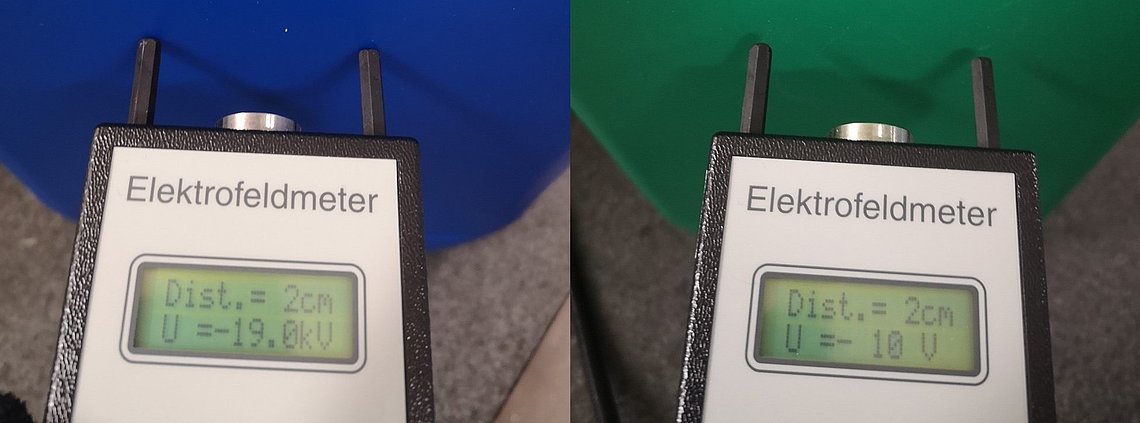On the safe side with MultiCan-Atex
![]() Müller Plastics
Müller Plastics
At first glance, there is not much difference between the two canisters on the table in front of Horst Meier, Key Account Manager at Müller Plastics. For an untrained eye, both are identical, apart from the colors. Nevertheless, the differences are significant: while the blue canister is an insulating stackable canister without dissipative properties, the green canister, which also has an insulating wall, moreover features a conductive outer layer. The so-called MultiCan-Atex, made of six different layers, is thus designed for use in explosive atmospheres, which is to say in so-called ATEX zones 1 and 2. One of these layers is the highly effective barrier layer out of ethylene-vinyl alcohol copolymer (EVOH), which makes sure that no gases escape from the container. Likewise, it prevents external smells and gases, such as for example oxygen, from penetrating the container. The inner layer of the canisters is pure high-density polyethylene (HPDE). The outer layer is made of a mix of HPDE and a conductive additive. This special layer prevents the occurrence of so-called brush discharges, which may lead to explosions during handling.
"We have been manufacturing this canister type in series since 2009", explains Horst Meier. "At that time, the aroma industry was looking for containers that would better prevent the diffusion of the substances. In the same time, our customers were asking for a solution for filling highly flammable liquids." Based on these needs, Müller Plastics developed today's MultiCan-Atex, which is now available in various sizes from 3 to 30 liters and in different colors. It is suitable for all substances of packing groups 2 and 3, and thus for substances with medium and low hazard. These include among others aroma and vegetable concentrates, essences, solvents, disinfectants, paints and varnishes. MultiCan-Atex is mainly used in specialty chemicals companies and in the food processing industry.
Electrostatic loads let sparks fly
In compliance with the "European Agreement on the International Carriage of Dangerous Goods by Road" (ADR), highly flammable products require suitable packaging as from a volume of five liters. The "Technical Rules for Hazardous Substances" (TRGS 727 "Avoidance of Explosion Hazards Due to Electrical Charges") precisely define these measures. It does not take much for an explosion when flammable substances are transported in usual canisters: electrostatic charges occur almost everywhere in our daily life. Man, clothing and other materials such as canisters can carry electric charges of several 10,000 volts. Sparks and brush discharges can occur already with charges exceeding 3,000 volts and lead to an explosion in explosive environments. The energy of such discharges depends among others on the air humidity and on the temperature.
"Unfortunately, TRGS 727 is not a law, but directives", says Horst Meier, "and some branches still have safety gaps and need further regulation." The companies, putting into market the filled containers, are not always aware, that they are in charge if an accident happens and this should not be underestimated. Generally, in such a case, the responsible person in the company will be the manager declared in the commercial register. MultiCan-Atex allows reducing this risk to an absolute minimum.
Regular canister with 19,000 volts
To demonstrate the electrostatic charges of the containers, Horst Meier holds an electrostatic field meter alternately against two canisters. The differences are huge: the blue canister, which has an insulating outer wall surface, displays 19,000 volts and keeps this voltage for a long period. The green conductive MultiCan-Atex canister only displays 10 volts. Even with a charge of several hundred volts, it would still be in the safe area, as the charges are quickly dissipated to the earth by the conductive outer wall. This requires earthing the MultiCan-Atex canister when filling and emptying it.
Conductive plastic canisters such as MultiCan-Atex have some advantages with respect to metal containers and can readily replace them: "Aggressive substances often lead to corrosion with steel. This affects the purity of the product. In addition, steel is not as flexible as plastic and dents may appear during transportation", says Horst Meier. Also the price-performance ratio is attractive compared with steel packaging. Müller Plastics guarantees the conductivity of its plastic canisters for at least two years.
MultiCan-Atex is under constant further development
Müller Plastics' canisters are manufactured in accordance with strict quality specifications and ensure full traceability of the whole supply chain. They are approved for food packaging, space-saving for transportation and UN-approved. Müller Plastics is constantly developing and perfecting its products. In collaboration with customers, we recently developed a new barrier cap and launched it on the market. The company is currently developing larger canisters and extending the conductivity of the containers from two to five years. And, thanks to the six-layer sandwich structure, Müller Plastics is flexible in regard to the choice of the materials and can design and manufacture containers according to individual customer requirements.


